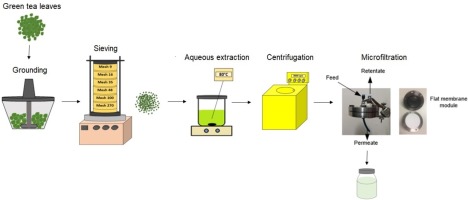当前位置:
X-MOL 学术
›
J. Food Eng.
›
论文详情
Our official English website, www.x-mol.net, welcomes your feedback! (Note: you will need to create a separate account there.)
Maximization of the polyphenols extraction yield from green tea leaves and sequential clarification
Journal of Food Engineering ( IF 5.5 ) Pub Date : 2019-01-01 , DOI: 10.1016/j.jfoodeng.2018.08.006 Marlon Menezes Maciel Bindes , Vicelma Luiz Cardoso , Miria Hespanhol Miranda Reis , Daria Camilla Boffito
Journal of Food Engineering ( IF 5.5 ) Pub Date : 2019-01-01 , DOI: 10.1016/j.jfoodeng.2018.08.006 Marlon Menezes Maciel Bindes , Vicelma Luiz Cardoso , Miria Hespanhol Miranda Reis , Daria Camilla Boffito

|
Abstract We designed a parametrical study to optimise the polyphenol liquid-solid extraction in green-tea by clarification by centrifugation followed by microfiltration through a 0.22 μm cellulose acetate membrane. Grounding, sieving and selecting the optimal granulometry (0.15–0.74 mm) increased the total polyphenol concentration by 14% compared to unground leaves, while using 61% of the initial tea leaves mass. The optimal polyphenol extraction conditions were water-to-tea ratio of 20:1 mL g−1, temperature of 80 °C, and extraction time of 60 min. The sequential clarification process decreased the turbidity of the extract (from 1197 to 13 NTU), while only reducing the polyphenol concentration by 13%. The permeate of the microfiltration process formed 82% less tea cream than the centrifuged extract after 30 days under refrigeration at 5 °C. This sequential clarification is suitable to produce a green tea extract with low turbidity and reduced tea cream.
中文翻译:

绿茶叶中多酚提取率的最大化和顺序澄清
摘要 我们设计了一项参数研究,通过离心澄清,然后通过 0.22 μm 醋酸纤维素膜微滤来优化绿茶中的多酚液固萃取。与未研磨的叶子相比,研磨、筛分和选择最佳粒度(0.15-0.74 毫米)使总多酚浓度增加了 14%,同时使用了初始茶叶质量的 61%。最佳的多酚提取条件是水茶比为 20:1 mL g−1,温度为 80 °C,提取时间为 60 min。连续澄清过程降低了提取物的浊度(从 1197 到 13 NTU),同时仅将多酚浓度降低了 13%。在 5 °C 下冷藏 30 天后,微滤过程的渗透物形成的茶奶油比离心提取物少 82%。
更新日期:2019-01-01
中文翻译:

绿茶叶中多酚提取率的最大化和顺序澄清
摘要 我们设计了一项参数研究,通过离心澄清,然后通过 0.22 μm 醋酸纤维素膜微滤来优化绿茶中的多酚液固萃取。与未研磨的叶子相比,研磨、筛分和选择最佳粒度(0.15-0.74 毫米)使总多酚浓度增加了 14%,同时使用了初始茶叶质量的 61%。最佳的多酚提取条件是水茶比为 20:1 mL g−1,温度为 80 °C,提取时间为 60 min。连续澄清过程降低了提取物的浊度(从 1197 到 13 NTU),同时仅将多酚浓度降低了 13%。在 5 °C 下冷藏 30 天后,微滤过程的渗透物形成的茶奶油比离心提取物少 82%。



























 京公网安备 11010802027423号
京公网安备 11010802027423号